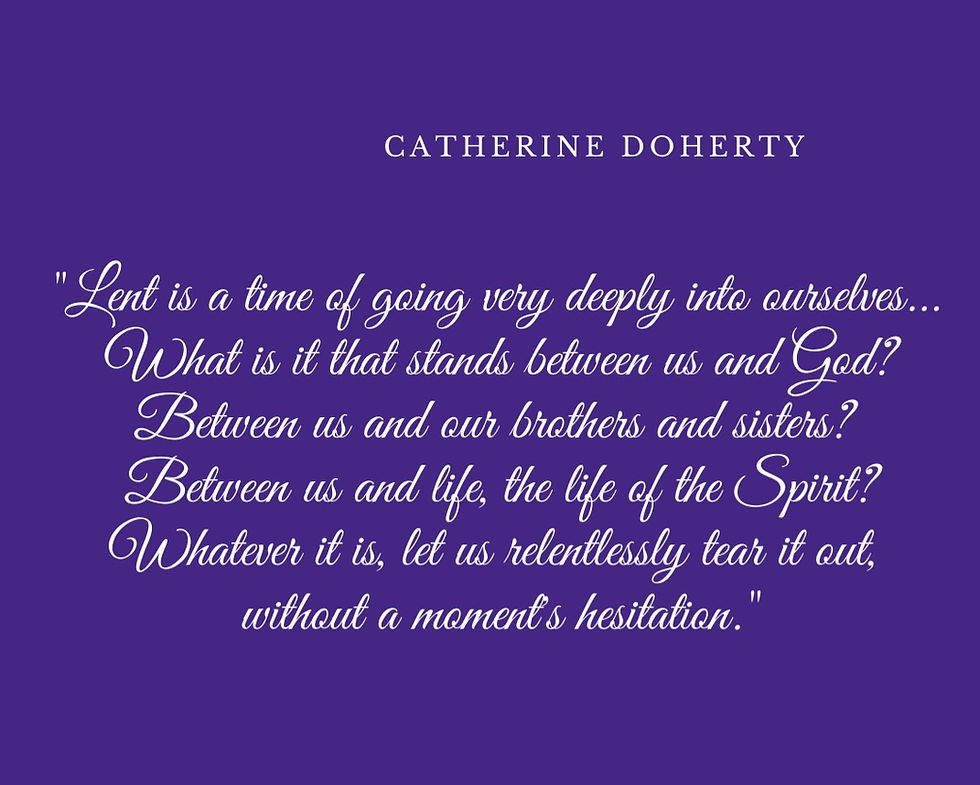Why Do We Celebrate Lent?
- Nadia Renata
- Feb 26, 2020
- 4 min read

Lent is a season of reflection, prayer and fasting. It is a six-week period that always begins 46 days before Easter Sunday; 40 days of fasting; Sundays are excluded. It is a period similar to Advent, which is in anticipation of Christmas but while Advent is a period of celebration, Lent is a time of solemnity in preparation for the death and resurrection of Jesus at Easter.
The Lenten period begins on Ash Wednesday and ends on Easter Sunday. Some of the key elements of Lent is as follows:
The Number 40: 40 is a significant number in Jewish-Christian scripture. In Genesis, the flood which destroyed the earth was as a result of 40 days and nights of rain; The Hebrews spent 40 years in the wilderness before reaching the promised land; Moses fasted for 40 days before receiving the ten commandments on Mount Sinai; Jesus spent 40 days fasting in the wilderness, which acts as the key event for the duration of Lent.
The Colour Purple: The official colour for Lent is purple. The colour is associated with mourning and therefore anticipates the pain and suffering of the crucifixion. It is also the colour associated with royalty, and celebrates Christ's resurrection and sovereignty. The Priest's Vestments is usually the deepest, darkest shade of purple. They also strip churches bare of most of the usual decorations adorning the walls and may at times cover some of the statues.
Confession: Lent is a period of reflection and repentance, so it would make sense that confession figures heavily during the period. It is recommended receiving the sacrament of confession at least once during the season.
Prayer and Fasting: You can do the traditional fast of staying away from all forms of meat and all animal products, with the exception of fish and/or refraining from meals from 6am to 6pm. Alternatively, you can abstain from vices such as alcohol and smoking, or from your favourite foods, like chocolates and sweets. Fasting is particularly powerful when paired with prayer and confession.

Charity/Almsgiving: As we meditate on the suffering of Jesus during Lent, we can also bring awareness of the suffering of others. Before Good Friday, choose one way you can increase your giving to those most in need, either through extra financial offerings, donating articles of clothing or household items that you no longer need or use to charity, or increasing your personal time commitment to a social cause close to your heart.
Palm Sunday which is the last week of Lent leading up to Easter, marks the beginning of Holy Week; the most solemn week in the liturgical calendar. It commemorates Jesus’ arrival in Jerusalem to observe Passover. Church Masses often include a procession of palm branches, symbolic of the ones laid at Jesus’ feet as he rode into the city. Palm crosses will also be distributed on this day, to be kept until the following year’s Ash Wednesday as a reminder of the death and resurrection of Jesus. These palms are then used as ashes on Ash Wednesday.
Palm Sunday is then followed by Holy Wednesday commemorating Judas Iscariot’s intent to betray Jesus. Holy Thursday marks the Last Supper Jesus shared with his disciples in which he predicts his betrayal by the following denial by Peter. It is accompanied by the washing of the feet of 12 humble or poor persons, in imitation of Jesus’ washing of the feet of his 12 disciples at the Last Supper. Holy Thursday is usually the day on which the anointing oils to be used in ceremonies during the year is consecrated. This is done at a special Chrism Mass.
Good Friday is the day on which Christians around the world remember Jesus’ crucifixion and burial. It is a day of mourning in Church. In some countries, there are special Good Friday processions, or re-enactments of the Crucifixion. The main service on Good Friday takes place at 3pm, the hour it is said that Jesus took his last breath on the cross. The parish altar looks very different on Good Friday, it is plain and bare: There is no consecrated Host in the Tabernacle at the main altar of the church since it was carried away on Holy Thursday night to the "altar of repose" to signify Jesus' death. The candle by the Tabernacle is blown out, and the Tabernacle doors are left open to show that it is empty.
Glorious Saturday, also called Easter Vigil, is the traditional end of Lent. The service is a vigil service held after nightfall. The idea is to mark the waiting and watching, hopeful and confident that Christ will return at midnight. The service traditionally begins outside the church. It is during this service that The Easter, or Paschal candle is lit. The lit candle is now a symbol of Christ's resurrection. After being lit outside, the candle is carried into the church, where most of the worshippers are waiting in darkness, which symbolises the darkness of Christ's tomb.
Easter Sunday is the celebration of Jesus’ Resurrection. It is the last day of the Easter Triduum (Holy Thursday, Good Friday and Easter Sunday), and is the beginning of the Easter season of the liturgical year. As per the Gospels, Jesus Christ rose from the dead on the third day following his crucifixion, which would be Sunday. His resurrection marks the triumph of good over evil, light over darkness, sin and death. Since Easter represents the fulfillment of God's promises to mankind, it is the most important holiday on the Christian calendar.




Comments